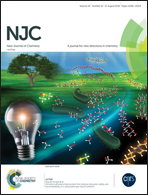Synthesis and cytotoxic characteristics displayed by a series of Ag(i)-, Au(i)- and Au(iii)-complexes supported by a common N-heterocyclic carbene†
Abstract
The synthesis, structures and anticancer studies of a series of precious metal complexes supported by 1-methyl-2-(phenyl)imidazo[1,5-a]pyridine-2-ylidene (1) have been highlighted. The Ag(I) (2), Au(I) (3) and Au(III) (4) complexes were prepared using standard methods and characterized by a range of techniques, including NMR spectroscopy, X-ray crystallography and elemental analyses. The in vitro cytotoxicity activities displayed by 2–4 were explored against human colon adenocarcinoma (HCT116), lung cancer (A549) and breast cancer (MCF7) cell lines. A series of assays showed that all of the complexes exhibited significant growth inhibition in the aforementioned cell lines. Inspection of the data collected revealed that the Au(I) and Ag(I) complexes were more potent than their Au(III) congener, a trend that was found to be consistent with molecular docking studies that utilized BCL-2 as a model as this protein regulates cell death through apoptosis.



 Please wait while we load your content...
Please wait while we load your content...